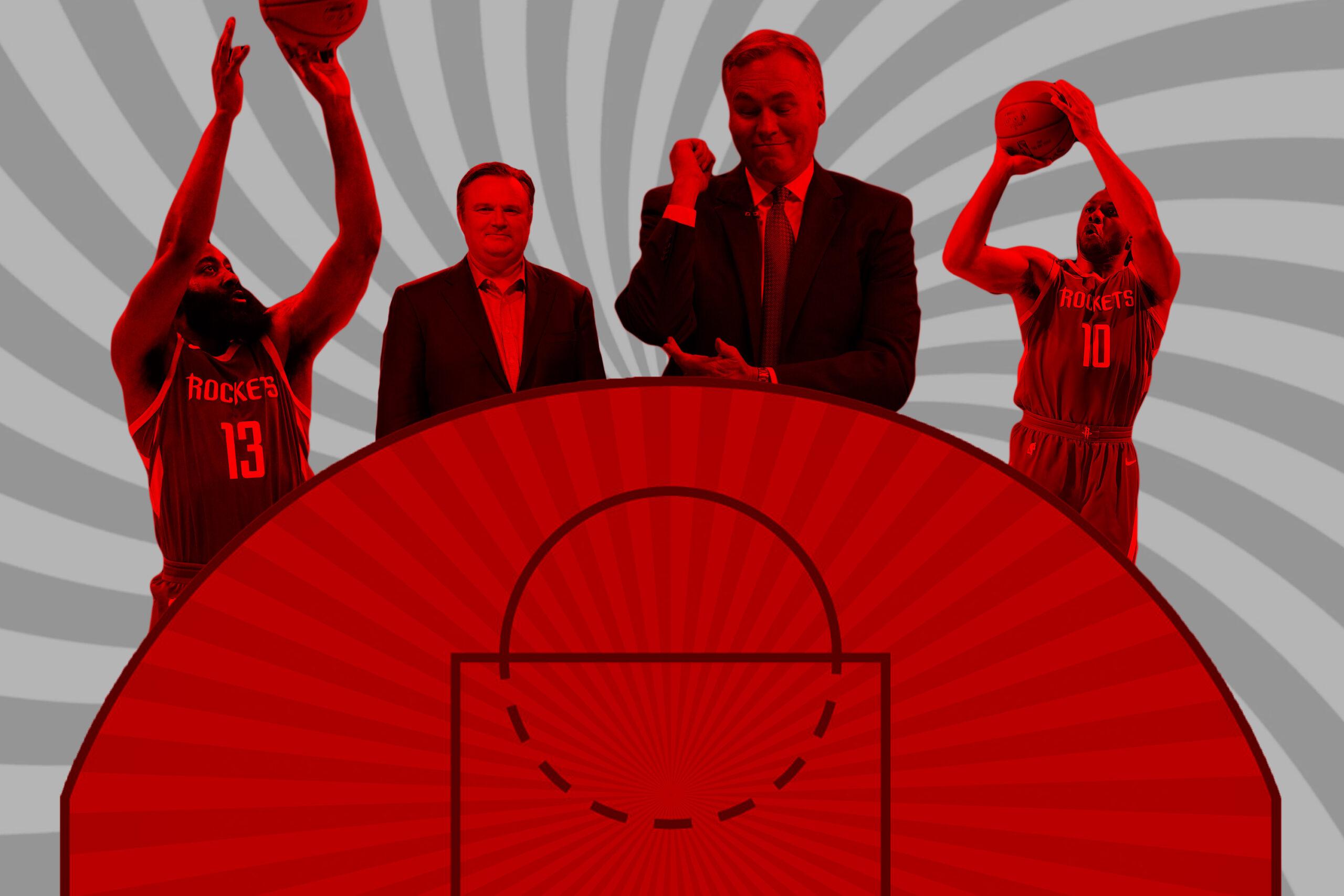
The most important performance of the Rockets’ early season was not the opening-night comeback win against the Warriors or James Harden’s 56-point scorcher against the Jazz on Sunday. That designation instead belongs to an otherwise mundane 109-93 win over the Hornets on October 27.
Harden recorded a triple-double (27 points, 10 rebounds, 11 assists) in that game, but the key statistic appears lower in the box score: Of Houston’s 85 shot attempts, 57 were 3-pointers. No factoid better captures the essence and experience of the 2017-18 Rockets than becoming the first team in NBA history to take twice as many 3s as 2s in a game. Daryl Morey and Mike D’Antoni must have been thrilled.
If the 2016-17 Rockets were an experiment—as The Ringer, SB Nation, and The Wall Street Journal all termed the eventual 55-game winners and conference semifinalists—in strategy, the 2017-18 version is an exploration of how far the strategy can be stretched and still work. The Rockets have planted their corn and built their homes; they know they can live—and prosper—in this new land of 3-pointers. But now they’re out paving the Oregon Trail while the rest of the league is still getting settled east of the Mississippi.
Pace-and-space is the 2017 NBA zeitgeist; across the league, 3s are flying more frequently than ever before. But it’s not just a matter of increased pace—currently at its fastest since 1988-89—artificially inflating totals. Here, we can make use of a simple stat: 3-point attempt rate (3PAr), which divides 3-point attempts by all field goal attempts. For instance, a 50 percent 3PAr signifies that a team takes exactly half its shots from distance.
The league-wide 3PAr has rocketed upward on both a nightly and macro level over the past 13 months. Before last season, teams had recorded a single-game 3PAr of 50 percent or higher 33 times in NBA history. Since then, they’ve done so 51 times. Seventeen of the top 20 team season totals come from last season or this one. But most teams still max out around 40 percent on aggregate. The full-season 3PAr record for a team other than Houston is Cleveland’s 39.9 percent last season, and Golden State leads this season among non-Rockets teams with a 39.0 mark.
The Rockets, meanwhile, are in their own orbit, taking more than half their shots from 3. Houston’s 3PAr rested at 46.2 percent last season, and this season’s team has boosted its rate to 53.4 percent—14 points higher than any non-Rockets lineup in history. The distance between Houston and second-place Golden State this season is larger than the difference between Golden State and 30th-place Sacramento. And the Rockets’ upper reaches extend far above their opponents’, too: Houston’s 3PAr in that game against Charlotte was 67.1 percent. For reference, Kyle Korver’s 3PAr over four-plus seasons in Atlanta was 67.8 percent.
Even as the league optimizes its shot distribution, the Rockets have accelerated their separation from the pack. Their 7.2 percentage-point increase in 3PAr from last season is the fourth-highest year-over-year jump in the NBA, which is impressive given that the Rockets had less room than any other team to boost their rate. Impressive—and daunting, like the most feared wizard in the world wresting control of the most powerful wand. Voldemort didn’t need the Elder Wand to perform remarkable feats of magic, but Mr. Ollivander—who devoted himself to wandlore like NBA Twitter to pace-and-space concepts—was still fascinated to think of the boundaries he could theoretically push.
The Rockets’ approach is engineered in calculated analytics, of course, rather than magic, and its on-court materialization can appear excessively clinical; the team’s shot charts resemble less a dynamic pattern and more a uniform drift past the arc. But the curiosity persists: What, and where, and how far out, are the limits? Could a team finish a game with 70 percent of its shot attempts from 3? Seventy-five? Eighty? What would an offense that fires four-fifths of its shots from range look like, and would it be distinguishable on a possession-by-possession basis from Houston’s current group, or even any standard, modernized lineup in 2017?
That Morey’s roster and D’Antoni’s offense are equipped to answer those questions makes Houston an anomaly in yet another sense. Rarely do professional sports offer such a pure opportunity to explore real-world manifestations of theoretical concepts. NFL teams try for strategic fourth-down conversions but would never follow the “never punt” Pulaski Academy ethos, and MLB clubs have come close to “bullpenning” single postseason games but would never apply the tactic for an entire season. But the Rockets keep launching 3s, thereby answering questions that had never before translated from whiteboards and video game screens to the actual court.
The early returns are promising, though not without schedule-related caveats. The Rockets have played only the Warriors among the top-tier teams, while they’ve already faced the Kings, Mavericks, 76ers (twice), Hornets, Knicks, and Hawks. Still, 3-happy Houston is tied for the league’s second-best record (8-3) and the third-best offense (108.4 points per 100 possessions), and the core lineup is faring even better than that latter number suggests. In a comparison between each team’s most-played lineup, Harden, Eric Gordon, Trevor Ariza, Ryan Anderson, and Clint Capela form the highest-scoring bunch, tallying 125.9 points per 100 possessions while maintaining a better-than-50-percent 3PAr.
The team has optimized its playbook with this plan in mind, pushing last season’s extremes even further. The Rockets already took the fewest middle-distance attempts in the league, and they’ve reduced their output from the spaces between the 3-point arc and restricted area from 15.8 shots per game in 2016–17 to 11.4 this season. Gordon is taking as many 3s (11.2 per game) as the entire team is taking shots from an enormous section of the court.
They’re not forcing 3s, either, as 38.1 of the Rockets’ 44.5 3s per game slot into the “open” or “wide-open” designations on NBA.com (the former describing when the closest defender is four to six feet away, the latter shots when the closest defender is six-plus feet away). Houston is attempting more wide-open 3s per game than half the league attempted total 3s per game in Harden’s first season with the Rockets.
And while the sample size is still small and one would expect the Rockets to regress from their outlier position as the season progresses, multiple factors suggest a large drop back to among the rest of the league—or at least their .462 3APr from last season—is unlikely. First, Houston broadcast its intentions early by embracing this style of play in the preseason. The team averaged 49.3 3-point attempts per game in those scrimmages, which amounted to 59.2 percent of its total shots. Even last preseason, before the Rockets set records with their long-range barrages, their 3PAr sat at a relatively low 41.4 percent.
Second, it’s not clear which Houston shooters would start taking fewer 3s. Among their top five players in minutes played, Harden’s 50.9 percent 3PAr is by far the lowest, and they’re all sufficiently capable shooters that such a strategy makes sense; even a 35 percent 3-point chance is worth more than a point per possession.
Houston’s 3-Point Shooters
And third, even the eventual return of Chris Paul—sidelined since opening night with a left knee injury—is unlikely to dim the Rockets’ long-range luster. Although Paul has existed as the “monster of the midrange” for years, he registered a 38.5 percent 3PAr last season, signifying a career high by nine percentage points, and has taken a whopping 63.3 percent of his shots in a Houston uniform (combining his preseason and opening night stats) from range.
Projecting forward, it’s unclear what Houston might discover about the efficacy and sustainability of its 3-point bonanza. Perhaps the upper bounds of 3PAr become asymptotic just past the two-thirds mark, and Houston’s showing against Charlotte represents a relative maximum rather than a middle point on a trend line. A two-thirds rate is massive and unprecedented, after all, and a roster full of Korvers might not carry an offense for anything more than a one-game blip. Or maybe such an extreme philosophy works as a regular-season gimmick but is doomed to founder in the playoffs; the Spurs didn’t struggle to stymie Houston’s attack in last year’s second round.
But it’s also so early in the 3-point revolution—the league’s 3PAr has increased by 49 percent just since Harden joined the Rockets—that we have no way of knowing. The league’s smartest minds have no way of knowing. But Morey’s is the only group furnished with both the right cast and strategic support to explore the new terrain and probe the furthest limits.
Perhaps it’s the opposite, optimistic case, and one day in the future, when every NBA starter is a 7-foot-2 point forward unicorn with 32-foot range off the bounce, a team taking half its shots beyond the arc, or even two-thirds, will be a nightly norm. The Rockets are charting that path early, thinking not just of 2017 but of the future, and undiscovered offensive riches beyond.
Leaguewide statistics through Tuesday’s games.

